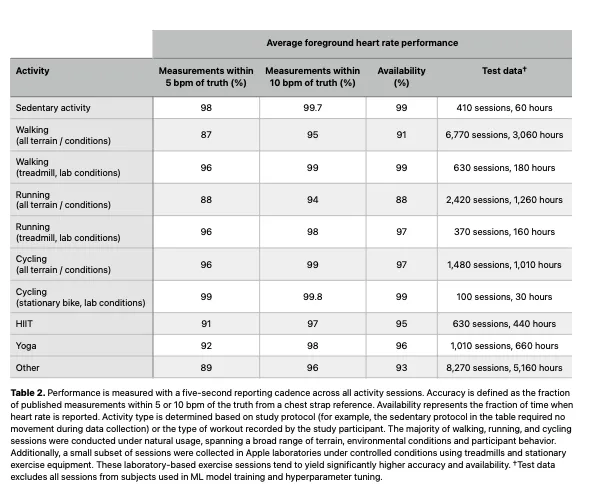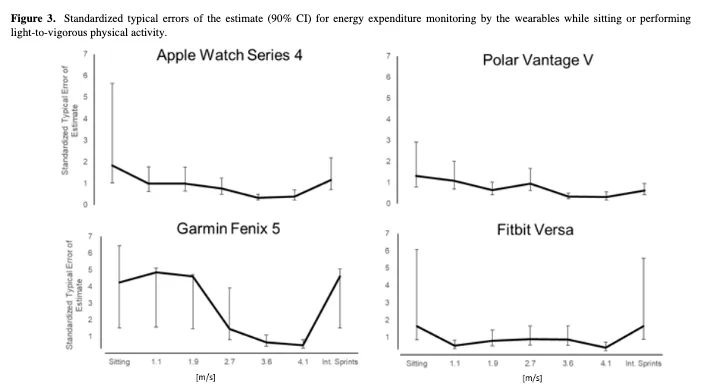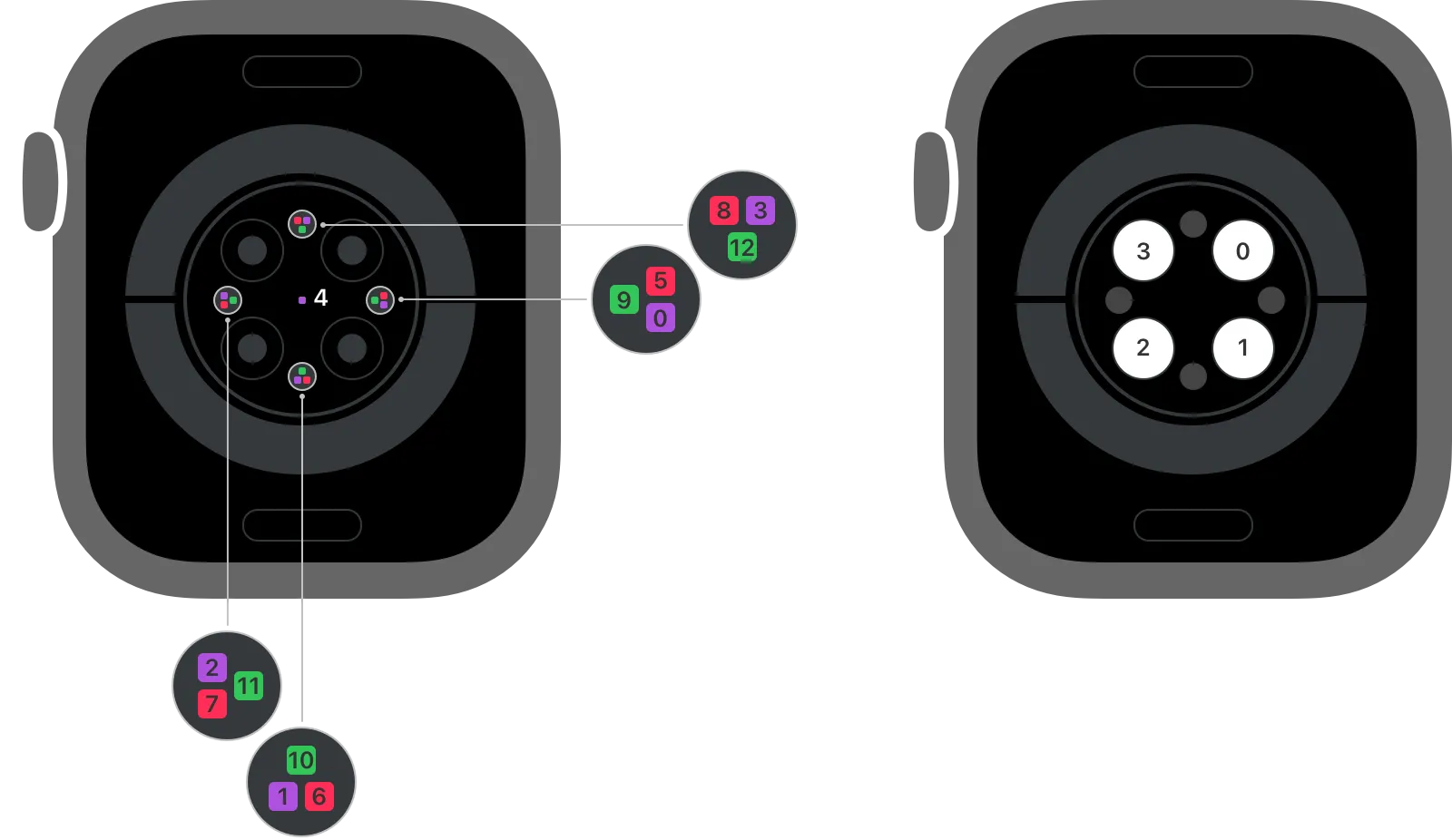Apple Watch’s heart rate monitor measures 10 major metrics of heart health, including HRV, hypertension, resting heart rate, cardio recovery, and more. But do we know how accurate the underlying heart rate sensor is?
Here’s what the data shows. The Apple Watch’s HR monitor is usually accurate within 5bpm:
 Accuracy of Apple Watch heart rate monitor in various settings, for foreground readings. Source: 2024 Apple study.
Accuracy of Apple Watch heart rate monitor in various settings, for foreground readings. Source: 2024 Apple study.
While sedentary, Apple Watch’s heart rate monitor is accurate to within 5bpm about 98% of the time. During exercise, about 87% of measurements are within 5bpm and 95% are within 10bpm of the ground truth. During background heart rate monitoring, which uses the infrared sensors, about 89% of measurements are within 5bpm and 98% are within 10bpm of the ground truth. (Later in this post, we’ll get into the details of the three different optical sensors and three different algorithms used by the Apple Watch. There’s a lot going on under the hood!)
These numbers are based on Apple’s own study involving tens of thousands of sessions comparing the watch itself to a gold standard in a custom-built academic lab. But you don’t need to take the manufacturer’s word for it.
Accuracy of Apple Watch heart rate monitor from academic studies
You might reasonably ask: have third party researchers, unaffiliated with Apple, validated the accuracy of the Apple Watch’s heart rate monitor? Several studies have been published.
 Accuracy of Apple Watch heart rate monitor vs Garmin, Fitbit, and Polar. Source: European Journal of Sports Science, 2023.
Accuracy of Apple Watch heart rate monitor vs Garmin, Fitbit, and Polar. Source: European Journal of Sports Science, 2023.
The Apple Watch’s heart rate monitor was accurate to within 2.3 bpm in a 2023 study of 60 healthy participants. Among patients with cardiovascular disease, a 2019 study found an average error of 6-7 bpm. Earlier studies on the Apple Watch Series 4, which used the second generation of sensors, found higher error. A 2019 study found a correlation of 70%.
How Apple Watch’s heart rate sensor works

Apple Watch’s optical heart rate sensor uses LEDs to shine light through your skin and an array of photodiodes to measure the light reflected back. There are three wavelengths of light used: green (525 nm), infrared (850-940 nm), and red (660 nm). The green and infrared light are used to measure your pulse, and the red light is used to measure your blood oxygen saturation.
Three generations of Apple Watch’s heart rate sensor
Since the Apple Watch launched in 2015, there have been three versions of the heart rate sensor. The first generation optical heart rate sensor was used from 2015-2017. The second generation was introduced in the Apple Watch Series 4 (2018) and is currently used in the Apple Watch SE2. The third generation was introduced in the Series 6 (2020), and included an oxygen sensor. The 3rd generation sensor is currently used in Apple Watch Series 10 and Apple Watch Ultra 2.
| Generation | Year Introduced | Apple Watch Models | Key Features |
|---|---|---|---|
| First gen optical heart rate sensor | 2015 | Apple Watch Series 1-3, SE | Basic heart rate monitoring |
| Second gen optical heart rate sensor | 2018 | Apple Watch Series 4, 5, SE2 | Improved accuracy, lower power consumption |
| Third gen optical heart rate sensor | 2020 | Apple Watch Series 6-10, Ultra/Ultra 2 | Blood oxygen monitoring capability |
| ECG Sensor | 2018 | Apple Watch Series 4 and later | FDA-cleared Class II medical device for electrocardiogram readings |
Apple Watch uses three heart rate monitoring algorithms
Behind the scenes, Apple Watch uses three different algorithms to measure your heart rate: foreground, background, and tachygram.
- Foreground: uses green lights to measure heart rate. The foreground algorithm is accurate to within 5bpm 98% of the time.
- Background: uses infrared light to measure heart rate. The background algorithm is accurate to within 5bpm 89% of the time, and 10bpm 98% of the time. Infrared lights are chosen because they use less power.
- Tachygram: uses green PPG to measure heart rate. 99.6% of tachygrams are within 5bpm of the ground truth when you’re in normal heart rhythm (sinus rhythm). In abnormal rhythms like atrial fibrillation, tachygrams are within 5bpm 95% of the time.
Tachograms are used to measure HRV (heart rate variability). The default measurement cadence is every 4 hours, but you can change this to 2 hours or every 15 minutes by enabling irregular rhythm notifications or afib history, respectively.
Optical heart rate sensor vs ECG sensor
The Apple Watch has two heart rate sensors: the optical heart rate sensor and the ECG sensor. The optical sensor uses light to measure your heart rate, whereas the ECG measures the electrical signals generated by your heart. A doctor can use the ECG to diagnose heart rhythm disorders, like atrial fibrillation, atrial flutter, supraventricular tachycardia, and more.
Health metrics derived from heart rate
We wrote a separate post on the 10 metrics derived from heart rate monitoring, as well as detailed posts on Apple Watch resting heart rate, Apple Watch cardio recovery, Apple Watch HRV, Apple Watch cardio fitness (vo2max).
Bottom line on Apple Watch heart rate monitor accuracy
In general, if you’re using the latest generation of Apple Watch’s heart rate monitor (Apple Watch Series 6 and later or Ultra 1 or later), the sensor is accurate. And in turn, that means the various metrics derived from the heart rate sensor are also reliable.
Get your free 30-day heart health guide
Evidence-based steps to optimize your heart health.
